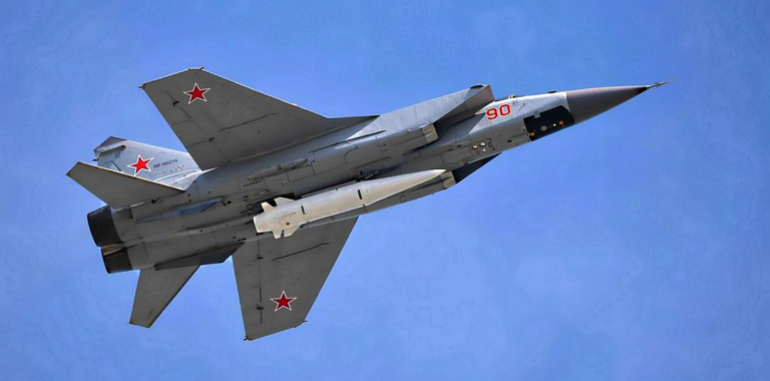For the first time, the Russian Defense Ministry's spokesman, Igor Konashenkov, revealed the use of hypersonic Kinzhal missiles against Ukrainian military sites.
According to a report published on the "Live Science" website, Konashenkov confirmed the destruction of about 70 Ukrainian military facilities within hours, including air defense systems.
Supersonic "dagger"
Russia claims that it used supersonic "Kinzhal" missiles - whose name means "dagger" in Russian - for the first time, in its invasion of Ukraine, and this military development may herald a new era in which these hypersonic weapons could dominate war.
Last Saturday (March 19), Russia announced that it had used the Kh-47M2 Kinzhal missile system to destroy a weapons depot in western Ukraine, according to a Reuters report citing the Russian Interfax agency.
On the other hand, the Russian state-owned TASS news agency reported in a report that the missiles had been deployed on an "experimental" combat mission since 2017 with a squadron of MiG-31K combat aircraft in Southern Russia.
But the Interfax report said that this is the first time that the "Kinghal" family has been used in combat in Ukraine;
Russia has never acknowledged using the missiles anywhere else.
Konashenkov, a spokesman for the Russian Defense Ministry, told a news briefing that the missiles destroyed an underground warehouse containing missiles and ammunition for Ukrainian planes.
"The Kinzhal hypersonic ballistic missile system destroyed a large underground warehouse containing missiles and aerial munitions in the village of Delatin in the Ivano-Frankivsk region," the Russian Defense Ministry said.
The Kinzhal missile is one of several high-tech weapons revealed by Russia in 2018 (Wikimedia)
perfect weapon
The hypersonic Kinzhal missile is one of several high-tech weapons that Russia unveiled in 2018. Russian President Vladimir Putin has called it the "perfect weapon", and so far it has been deployed on Russian aircraft, such as the MiG-31K. ".
Its payload of around 480 kg is usually a high-explosive warhead, but the Kinzhal can also be armed with nuclear warheads of the same size - the equivalent of between 100 and 500 kilotons of TNT.
Russian media sources reported that the "Kinzhal" missiles launch at a speed of more than 4 times the speed of sound, 5,000 km / h, shortly after its launch, and at a speed of up to 12 times the speed of sound, 14,800 km / h, with a range of up to 3,000 km.
Military experts see the speed and penetration of the "Kinghal" missiles as a special threat (YouTube)
The Kinjal is considered a "hypersonic" missile, faster than Mach 5, or 5 times the speed of sound, and the physical changes in the supersonic airflow become important at such speeds, and thus represent a difficult system for space engineers.
The idea behind the design is that the Kinzhal missiles move so fast that they are nearly impossible to track and intercept.
It is also said to perform sharp maneuvers while flying at supersonic speeds that enable it to evade enemy missile defenses.
The missiles' very high speed also makes them more capable of penetrating heavily armored targets, such as the underground armory in western Ukraine that is said to be the target of the final strike.
Radically changing the balance of power
Several countries are developing hypersonic missiles, including the United States and China.
But China's hypersonic missiles appear to be experimental, and the United States does not plan to deploy hypersonic missiles before 2023, the Arms Control Association reported.
Russian hypersonic missiles could radically alter the balance of power in the Pacific, according to a 2018 article in The Diplomat.
The main advantage of using Kinzhal missiles in the Ukrainian crisis may be psychological warfare (YouTube)
While Chinese air-launched hypersonic missiles seem designed to attack aircraft carriers in the South China and East China Seas as well, the Russian "Kinzhal" missiles pose a significant threat because they are larger and travel at higher speeds, which means that their kinetic energy alone, regardless of their heads Warships, can be powerful enough to disable or destroy major warships.
The article notes that if the Kinzhal missiles are deployed in Russia's Far East, it could have "important repercussions on the balance of power in the Pacific", by allowing Russian aircraft to target US warships as far as 3,500 km from its coast.
Military experts believe that the speed and penetration of the "Kinghal" missiles pose a special threat;
But Russian military analyst and journalist Pavel Felgenhauer told Euronews after the latest attack: "Basically, it doesn't change the battlefield, but it certainly has an impact in terms of psychological propaganda, to scare everyone."

